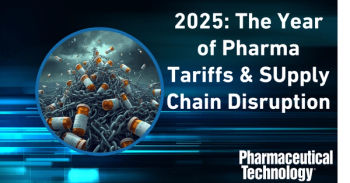
- Pharmaceutical Technology-04-02-2021
- Volume 45
- Issue 4
Supply Chain Challenges Creating Hurdles to COVID-19 Vaccine Production
The availability of materials is a critical factor when it comes to vaccine capacity.
Monumental challenges are facing manufacturers, contract development and manufacturing organizations (CDMOs), and suppliers during the evolving situation in the manufacture of COVID-19 vaccines. BioPlan Associates interviewed front-line bioprocessing decision-makers to assess and highlight the general bioprocessing, raw materials, and supply chain challenges associated with COVID-19 vaccines, together with need for approaches to moderate risks and avoid delays. The following are key challenges for COVID-19 vaccine manufacturing and supply chains.
Availability of materials
The most critical factor raised in regard to COVID-19 vaccine manufacturing has been the availability of materials. While this has not been entirely unexpected, the delays and challenges have stressed the supply chain severely. From basic raw materials (e.g., buffers, resins, sodium chloride), to consumables (e.g., single-use bags, tubing, sterile filters) and fill/finish (e.g., vials, stoppers)—these all need to be available and in place for the system to function. Delays for delivery of some of these materials are forecast to be 12 or 15 months; sterile filters delivery times have been extended from 2–3 months to 9–12 months; lead-times also have extended for media and chemicals. And while some suppliers have the ability to expand with flex-capacity—a glass vials supplier is increasing output by five times—most do not.
Where suppliers can’t supply, they’re making priorities. The common view was that one needs to see the whole picture of demand with critical stock available for everyone to access. This ‘emergency’ supply chain management is new to the industry and is evolving. Suppliers are used to having known, predictable demand. As demand has increased considerably, old methods are now ineffective. For users, it is not straightforward to bring on and qualify new suppliers. There are some key materials (e.g., vials, syringes, stoppers, seals) from a limited number of suppliers, which limits flexibility to increase the supplier base.
With suppliers setting priorities, companies are receiving notifications (e.g., single-use materials, resins) to re-confirm and re-route deliveries. There’s the risk of over-ordering and creating safety stocks, which creates inefficiencies across the industry.
Recognizing how interconnected the bio/pharma industry is, and how shortages in one area affect other medicines, is critical to defining any solution for improving materials distribution and logistics.
People and ways of working:Impact of COVID-19
During the COVID-19 crisis, it’s been a challenge simply to keep manufacturing facilities open and running. One company with seven sites, all of which needed to be kept open, developed new ways of working. This experience has, of course, accelerated implementation of remote working practices, previously seen as having significant blockers.
Starting in mid-2020, the bioprocessing industry performed an impressive and rapid response to transfer and scale-up despite lack of clarity on basic information (e.g., on final formulation, stability data, dosage, and volumes). In addition, forecasting has been difficult; the volume and scales required for COVID-19 vaccines and therapies are a new experience for many companies. In one example, with work starting in mid 2020, the first commercial-scale vaccine material under good manufacturing practice (GMP) was produced in November 2020. However, this speed of response has resulted in less-than-optimal processes requiring further work to improve robustness of the process, and to respond to increasing demand volumes.
The industry also needs to consider ‘people resources’ capacity. Bio/pharma companies need people with the right education and pharma-specific skills. It is now near-impossible to source expertise across regions—both for manufacturing and support functions.
Manufacturing capacity and supply chain
The overall view of those interviewed is that COVID-19 challenges are likely more centered on the fill/finish activities rather than drug substance manufacture. With low dosing, relatively small amounts of active product are needed to then manufacture large volumes of drug product.
Even before the pandemic, there has been experience of shortages of biological manufacturing equipment and supplies (e.g., bioreactors, single-use devices, analytical support), as organizations planned against a changing product and service portfolio. The ability to respond is now compromised, as travel restrictions make it difficult to have vendors on site to install and qualify new equipment (e.g., filling lines). One company BioPlan spoke with estimated a one-year delay to commission new facilities.
For processing capacity, the challenge is probably not stainless-steel vessels, because many vaccines are produced via single-use systems. In terms of global capacity, there does not seem to be an overall or strategic view of capacity availability and awareness of capacity builds; a better overview and coordination of demand and capacity across the bio/pharma industry is needed. The ad hoc approach to bioproduction of the various vaccines in development and in production has, and will continue to, lead to competition for raw materials, consumables, and supplies.
For COVID-19, the industry has come together in the short/medium term on the technical side, but this collaboration is limited in terms of resource allocation and supply of materials, both for COVID-19 and other medicines. The concern is how sustainable these technical collaborations may be in the longer term. What will normal capabilities be after the pandemic?
For example, the bio/pharma industry has focused on COVID-19 and this has been well supported by in-house quality assurance and regulatory functions and the regulatory authorities. This enabled accelerated approval and rapid product clearance for patients. COVID-19 vaccine production is creating significant bottlenecks in the biologics supply chain, and it’s unclear how this may be impacting the wider portfolio with other products in development and already in commercial supply.
Existing and new business
Bio/pharma businesses continue to look to grow through increased capacity to meet existing customer demands (e.g., as CDMO service providers and to manufacture biosimilars). There has been significant new demand (drug substance and product) since mid-2020 in response to COVID-19. The ability to respond can be in direct competition to existing business, made more challenging with the high expectation on speed of response. From an overall business perspective, there’s clearly the challenge to respond to COVID-19, but also continue to supply other medicines and treat other ill patients.
Investors (including government) have been providing financial support and are taking risks to support the development of COVID-19 vaccines and therapies. It seems, however, that the cost of goods and sales price have not been significant drivers. The business is being driven by the need to reopen the world; this drive and investment has enabled access to, and speed of, the COVID-19 supply chain.
Increasing capacity demands
The overall view of manufacturers interviewed is that there may be sufficient (even if near 100%) available bioproduction capacity, if it could be efficiently coordinated. Despite capacity being available around the world, issues of intellectual property, regulatory factors, and quality challenges must be rapidly resolved in order to make capacity useable. The challenge here is how to become more flexible with how existing, available capacity is used and maintain a balance across the whole product portfolio.
For example, there’s the potential renaissance of the stainless-steel vessel as an enabler of mass production. Clients want to avoid shortages, and there seems some movement back to stainless rather than single-use systems, if technically feasible. There is the view from some that even if external capacity is available, some companies would still prefer to develop in-house, rather than have the delays (greater than six months) of qualification and technology transfer to a third party. For some organizations, there’s the preference to ramp up production capacity and scale up capabilities internally. There are, for example, some domestic facilities in China that have considered offering GMP large-scale capacity to the production of vaccines in order to create access to international markets. Despite the challenges in drug substance manufacture, the industry explicitly needs adequate fill/finish capacity to meet increasing global volumes for vaccines and other therapeutics that are being sidelined for vaccines production.
The bio/pharma industry has gained experience and efficiency over the past three decades, but nothing could have prepared it for the dramatic impact of the COVID-19 pandemic. Yet, it has risen to the crisis with remarkable speed. From development to vaccine delivery, the industry has created a scientific equivalent of the Wirtschaftswunder, the rapid reconstruction of German industry following World War II.
Yet this has not been without impact on the underlying industry. One of the key challenges the bio/pharma industry has faced in recent times is managing and balancing its overall available capacity. Too much excess, or unused capacity, and costs can skyrocket. Too little capacity, and life-saving medicines do not get manufactured in time. Thus, measuring production capacity and capacity utilization has been important in assessing the industry’s ability to balance supply and demand. The pandemic exploded this delicate balance, and even manufacturers not directly impacted by the pandemic were finding a ripple effect as projects displaced by COVID-19 ended up with other producers.
Figure 1 shows data from BioPlan’s 17th Annual Report and Survey of Biomanufacturing Capacity and Production (1). It shows the average production capacity in various bioprocessing platforms, by biotherapeutic developers, and by contract manufacturing organizations (CMOs). For reference, 17 years ago, in 2004, mammalian cell culture capacity utilization was 76.4% (vs 68.2% just prior to the pandemic). However, in 2004, the industry news was about the disastrous ‘capacity crunch’ the imbalance between demand for production capacity and what had been built at the time. Today, some have projected short-term capacity utilization for vaccines production significantly higher than during that ‘crunch’ period. While COVID-19 vaccines production is a transient event, the impact is real, and likely to be long-lasting. As COVID-19 projects displace existing or pending drug production, many non-COVID clinical trials are at risk for delays. This affects patients, companies, and investors.
Process and supply chain efficiencies
Rather than building and qualifying new facilities or outsourcing, another strategy to increase capacity is to improve process efficiencies and robustness. This problem has increased due to accelerated development and approvals; processes are not developed for mass volumes. A solution is needed to improve capabilities to deliver better processes. This includes considering planning the process and the scale up in order to manage the capacity now, through, and after the pandemic.
The same may be said about improving efficiencies across the supply chain. In discussion with industry experts, there’s the belief that there are opportunities to increase supply chain speed further in addition to the accelerated approvals seen via regulatory authorities’ fast-track approvals.
Industry initiatives to optimize manufacturing and supply chains
Most experts interviewed were not involved in or aware of significant initiatives underway to optimize supply chains; there is a lack of transparency to share issues and information in real time. There was some variance in views as to whether the industry should coordinate ‘pandemic preparedness’; the industry has responded well with little apparent formal coordination.
There seems desire to align across the industry, but the reality is that companies are likely to still want to keep to their own practices. It’s been difficult to ‘predict the race’. With the variety of organizations and approaches, it would be very difficult to standardize longer-term preparedness. Some organizations have experienced significant growth due to COVID-19, but again this introduces more complexity to establish industry best practices and approaches.
Industry groups are working in this space (e.g., cross-industry forecasting). There are ongoing challenges to secure adoption of new ways of working, due to legacy regulatory and quality/compliance practices and established organizational culture. Some respondents expressed concern that after the emergency, the industry will go back to its normal ways of working.
Conclusion
The most critical factor raised regarding vaccine capacity has been the availability of materials. The industry must see the whole picture of demand with critical stock available for all stakeholders to access.With this holistic view, there should be better understanding of how supply chain challenges create shortages and how then to prioritize certain medicines and organization resources.
COVID-19 response has accelerated implementation of new ways of working, but will these new approaches stick after the pandemic?
The ability of a company to respond to COVID-19 can be in direct competition to existing business. It’s unclear what the impact is on the wider portfolio with other products in development and in commercial supply. Speed of response has resulted in non-ideal processes requiring further improvement to respond to increasing demand volumes. The solution is not just about making more capacity available, it’s more about capabilities to deliver better processes and supply chains.
Most experts interviewed were not involved or aware of significant initiatives underway to create long-term solutions to the problems that have surfaced regarding pandemic-level production challenges. Part of this is the result of a lack of transparency to share issues and information in real time.
The industry needs a better overview and coordination of demand and capacity and a network to solve problems together. Industry needs to become more flexible with how capacity is used—in particular, adequate fill/finish capacity to meet increasing global volumes, including new products in development. It is unlikely that this will be the last pandemic the bio/pharma industry will need to respond to.
Reference
BioPlan Associates, 17th Annual Report Biopharmaceutical Manufacturing Capacity and Production, BioPlan Associates, Inc. April 2020, www.bioplanassociates.com
About the Author
Jonathan Dakin is a collaborator with BioPlan Associates, Inc.
Article Details
Pharmaceutical Technology
Vol. 45, No. 4
April 2021
Pages: 60–64
Citation
When referring to this article, please cite it as J. Dakin, “Supply Chain Challenges Creating Hurdles to COVID-19 Vaccine Production,” Pharmaceutical Technology 45 (4) 2021.
Articles in this issue
over 4 years ago
Advanced Manufacturing Technologies Shift Outside the Boxover 4 years ago
Reshoring and Expanding API Manufacturing Capabilitiesover 4 years ago
Balancing the Art and Science of Topical Drug Formulationover 4 years ago
Focusing on Accelerated Formulation Strategiesover 4 years ago
Understanding the Impact of Annex 1 on Isolator Operationover 4 years ago
Blocking the Threat of Counterfeit Medicinesover 4 years ago
Limitations and Advances in Dissolution TestingNewsletter
Get the essential updates shaping the future of pharma manufacturing and compliance—subscribe today to Pharmaceutical Technology and never miss a breakthrough.




